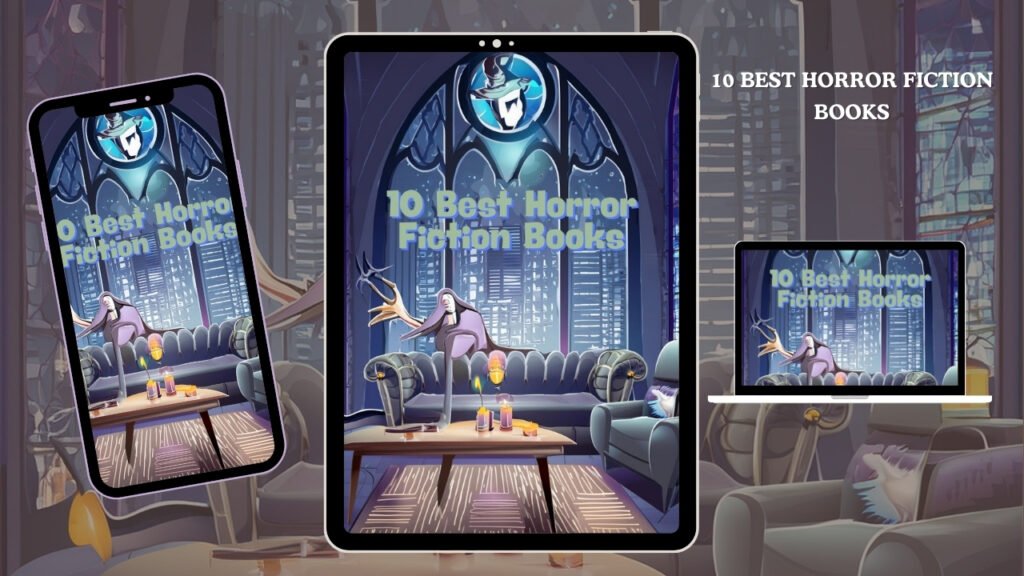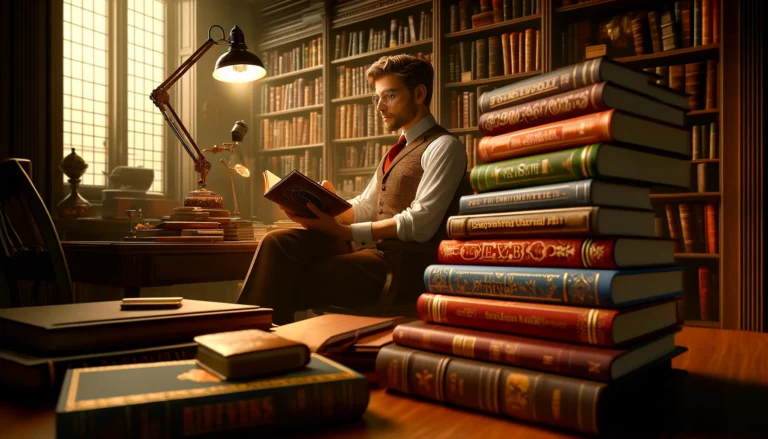Introduction
Welcome to the dimly lit corners of horror literature, where each story isn’t just a tale but a deep, dark reflection of our fears and morality. This article is your guide to ten chilling horror novels that do more than scare they unsettle and provoke. Prepare to meet authors who masterfully manipulate shadows and suspense to explore the complexities of human vulnerability. From Stephen King’s haunting narratives to Shirley Jackson’s psychological twists, each book promises a journey into the heart of terror. Whether you’re a seasoned aficionado or a curious newcomer, these selections will linger in your mind, challenging your bravery and your understanding of horror. Discover why these ten masterpieces are not just readings, but experiences that will leave you looking over your shoulder long after the last page is turned.
1. The Shining by Stephen King

Stephen King transforms the mundane into the menacing in “The Shining,” where the Overlook Hotel serves not just as the setting but as a character steeped in malevolence. This novel goes beyond traditional horror by delving into the psychological torment of its characters, intertwining the supernatural with a harrowing study of family dynamics, addiction, and the fragility of the human mind. King uses everyday elements from the sinister topiaries to the eerie Room 237 to amplify the terror, crafting scenes that turn the familiar into the fearsome.
The story captures the slow unraveling of Jack Torrance as he confronts the hotel’s dark history and its impact on his own violent tendencies. King’s narrative forces us to face the unsettling truth about the inheritability of sin and the cyclical nature of violence, challenging us to reflect on our own hidden fears. His use of a conversational tone pulls the reader into a chilling dialogue, making the spectral horrors of the Overlook feel unnervingly personal.
2. House of Leaves by Mark Z. Danielewski

“House of Leaves” by Mark Z. Danielewski isn’t just a novel, it’s a psychological and typographical maze that distorts the very notion of reading. At its heart lies a house with impossible dimensions, serving as a dark mirror to the expanses of the human psyche. The book doesn’t merely defy traditional storytelling it obliterates it, pulling the reader into a spiraling descent where reality bends and text becomes a labyrinth.
Danielewski crafts a multi-layered narrative that challenges perception, footnotes lead into deeper footnotes, and pages rotate, forcing readers to physically and mentally navigate through a disorienting narrative structure. This design isn’t just innovative, it’s a visceral representation of the novel’s chaotic, shifting environment, mirroring the unsettling transformation within its walls.
The book delves deep into the horrors of obsession, family, and loss. It goes beyond exploring cultural and emotional landscapes, it makes you live them. Each page turns into a psychological trial, not just unfolding a story but actively fracturing the comfort of traditional narrative forms.
3. The Haunting of Hill House by Shirley Jackson

Shirley Jackson’s “The Haunting of Hill House” is a cornerstone of psychological horror, masterfully intertwining deep emotional currents with suspense. The novel goes beyond the haunted house trope, diving into the troubled psyche of its main character, Eleanor. Her profound longing for a place where she belongs makes the eerie Hill House not just a backdrop, but a living, breathing antagonist in its own right.
Jackson employs her narrative genius to make the house’s presence so palpable and menacing that it blurs the lines between the supernatural and the psychological. Readers are compelled to question what they perceive as reality, pushing the boundaries of traditional horror storytelling. The novel’s exploration of isolation, mental illness, and identity not only provokes fear but also introspection, challenging us to confront our own inner darkness.
Through a conversational tone, Jackson intimately connects us with Eleanor’s spiraling descent into madness, making her unraveling both personal and profoundly unsettling. With each meticulously crafted sentence, Jackson assures us that each chilling detail contributes to a broader, terrifying narrative. “The Haunting of Hill House” doesn’t just offer a journey into supernatural realms, it holds up a mirror to our own vulnerabilities, making us ponder what truly terrifies us.
4. Pet Sematary by Stephen King

King drags us through a visceral portrayal of a family’s profound sorrow, making the reader feel every bit of the cold, damp earth of the cursed Pet Sematary. It’s not just grief depicted on the page, it’s a palpable, raw emotion that clings to your skin. As the family’s decisions spiral into horror, King forces us to confront the uncomfortable truth about our own vulnerabilities and the lengths we might go to avoid accepting loss.
The burial ground itself is characterized with a chilling autonomy, looming over the narrative as a beacon of inevitable doom. King masterfully uses this setting not just to unsethrall but to implant a creeping dread that festers long after the book is closed. He intensifies this effect with a conversational tone that pulls the reader into the narrative, making the horror uncomfortably intimate.
Themes of resurrection and the ethics of tampering with fate are woven through the narrative, not as mere philosophical queries but as a harrowing exploration of the human psyche. King doesn’t just ask what it means to cheat death, he shows us the grotesque consequences of such actions, holding up a mirror to the darkest parts of our nature.
“Pet Sematary” is more than a meditation on death, it is a confrontation with it, enveloped within the terrifying trappings of a horror masterpiece. This book compels us to face our deepest fears about death and loss, making the horror not just something to be read, but something to be experienced a true test of our capacity to handle the unthinkable.
5. Bird Box by Josh Malerman

In “Bird Box,” Josh Malerman masterfully crafts a post-apocalyptic scenario where the simple act of seeing can be deadly, transforming the mundane into the ultimate peril. Sight becomes a liability in this terrifying new world, compelling the protagonist a mother fiercely determined to protect her children to navigate blindfolded through a landscape filled with unseen threats. Malerman heightens the tension to almost unbearable levels, as every rustle or whisper could herald a gruesome end.
Through vivid language, Malerman intensifies the horror of sensory deprivation. Readers are plunged into a world where they must rely on the characters’ other senses to paint a terrifying picture of their surroundings. This technique not only amplifies the fear of the unknown but makes the unseen palpably horrific, with every sound and breath potentially hiding deadly consequences.
The novel delves deeply into primal fears, not just of the characters but of humanity at large. The mother’s drive to protect her offspring is portrayed with a raw, primal intensity, turning every moment into a high-stakes survival horror. This relentless pursuit of safety in a blind world showcases the novel’s core examination of fear, the unknown, and the fragility of society.
Malerman’s conversational tone adds to the intimacy and urgency of the narrative, making the suspense personal and immediate. Each page tightens the claustrophic tension, drawing readers deeper into the dark, whispering corners of fear.
“Bird Box” challenges readers to confront their own perceptions and vulnerabilities in a world deprived of sight, making it not only a journey into fear but a disturbing exploration of what it means to be human in the face of pervasive, unseen dangers. This novel doesn’t just provoke thought, it claws at our comfort zones, forcing us to question the reliability of our senses and the security of our environment.
6. The Exorcist by William Peter Blatty

William Peter Blatty’s “The Exorcist” is not merely a tale of demonic possession but a profound battle for the human soul, set against the backdrop of eternal stakes. The novel plunges into the emotional abyss as it portrays a mother’s horror at her daughter Regan’s monstrous transformation and a young priest’s harrowing journey through a crisis of faith. Blatty’s narrative goes beyond mere storytelling to unleash a palpable terror in the reader’s mind.
Blatty’s vivid language doesn’t just describe the scenes, it makes the supernatural horror visceral. When Regan speaks with voices that are not her own, or her body contorts in grotesque defiance of natural laws, the horror is not just seen but felt, attacking the reader’s sense of reality. Each description is a crafted nightmare, intended to leave you unnerved and restless.
The novel also engages in a theological and existential wrestling match, presenting not only meticulous debates about the paranormal but also forcing the reader to confront their own beliefs about the existence of evil and the potency of faith. These are not just intellectual exercises, they are emotionally charged discussions that challenge the foundations of the reader’s worldview.
Blatty’s conversational tone does more than make the complex themes accessible it makes the demonic presence feel alarmingly close, as if whispered directly into the soul. This approach deepens the horror, making it an invasive, unsettling experience that lingers long after the pages are turned.
“The Exorcist” compels readers to confront and question the nature of good and evil, as well as faith and doubt. It is a narrative crucible where these concepts are not merely explored but are exorcised, providing a profound, chilling reflection on what it means to wrestle with the deepest fears. This novel isn’t just a read, it’s an emotional and spiritual confrontation, demanding a reckoning with the darkest aspects of human nature and spirituality.
7. Hell House by Richard Matheson

Matheson expertly crafts a narrative that strips the characters to their core, exposing their deepest fears and vulnerabilities. The emotional and physical toll is depicted with brutal honesty, turning each page into a mirror of their internal torment. As they navigate the house’s oppressive atmosphere, Matheson’s vivid language ensnares the reader in a claustrophobic grip of dread, making every shadow and silence scream with threat.
The novel’s exploration of survival, the paranormal, and the power of belief delves deep into the psyche, challenging not only the characters’ perceptions but also those of the readers. Matheson forces us to question the fabric of reality, weaving a tale so immersive that the supernatural seems not only possible but inevitable.
Utilizing a conversational tone, Matheson makes the terror intensely personal and disturbingly relatable. This approach doesn’t just draw readers into the narrative it traps them there, making the escalating horror feel like a personal violation. The suspense builds to a climactic confrontation that not only tests the boundaries of the characters’ sanity but also dares the reader to look away.
“Hell House” does more than deliver scares, it offers a profound commentary on the scars that such psychic wounds can leave. This novel is a relentless journey into the darkest corners of fear, where the true horror is not just the haunted house but what it reflects about our inner selves. It’s not just a story, it’s an ordeal that challenges the very essence of reality and sanity, leaving a lasting imprint long after the haunting ends.
8. Frankenstein by Mary Shelley

Mary Shelley’s “Frankenstein” is not merely a timeless classic, it is a profound exploration of the enduring human dilemma of creation and consequence. This novel captures our fascination with boundary-pushing innovation mirroring the modern-day Victor Frankensteins in genetic engineering and AI. Shelley intensifies this exploration through her tragic protagonist, the Creature, who reflects not only Victor’s unchecked ambition but also the darker facets of human nature itself.
In “Frankenstein,” the stark, icy desolation of the Arctic is not just a backdrop but a mirror to the existential void within both creator and creation. This setting amplifies the chilling isolation that pervades the novel, enhancing the thematic depth of societal exclusion and self-inflicted solitude.
Shelley’s language itself weaves this coldness into the narrative, with descriptions that are as vivid as they are chilling. Consider the scene where Victor first beholds his monstrous creation coming to life, an image both horrifying and pitiful, encapsulating the novel’s haunting ethical quandaries.
The novel compels readers to confront these moral dilemmas head-on, presenting a nuanced discussion on the limits of scientific exploration. It prompts us to question not just the nature of humanity but also the ramifications of our relentless pursuit of knowledge and power. Shelley’s work challenges us to reflect on our own potential for monstrosity, suggesting that we are all, in some ways, assembled from fragments of ambitions, fears, and desires, much like her Creature.
By delving into these complex layers, “Frankenstein” asserts itself not only as a pivotal piece of gothic literature but also as a critical commentary on the human condition, making it an undeniably rich and relevant read.
9. Dracula by Bram Stoker

Bram Stoker’s “Dracula” transcends the traditional boundaries of horror to redefine the vampire mythos, creating an archetype in Count Dracula that is as sophisticated as it is sinister. This novel isn’t just foundational for introducing elements like the vampire’s aversion to sunlight and reliance on human blood, it infuses these with a palpable tension that resonates with the era’s anxieties about sexuality and the clash of old-world superstition with burgeoning scientific rationalism.
Stoker’s narrative thrives on the palpable fear of his characters Jonathan Harker’s dread as he encounters Dracula’s supernatural prowess provides a chilling entry into the novel, while Lucy’s transformation from an innocent to a nightmarish predator dissects the Victorian fears of corruption and the loss of purity. Stoker’s language rich with Gothic elements meticulously crafts scenes filled with foreboding, such as the oppressive gloom of the Carpathian Mountains and the sinister atmosphere of Dracula’s castle, where every shadow and whisper builds the ominous mood.
The novel’s engagement with folklore, particularly the juxtaposition of ancient superstitions and modern science, cleverly mirrors the societal tensions of Stoker’s time. This is masterfully shown in how the characters employ contemporary science alongside old beliefs to combat Dracula, embodying the era’s conflict between the known and the mysterious.
Moreover, the epistolary format of “Dracula” not only pieces together the narrative through a patchwork of perspectives but also heightens the suspense. Each diary entry or letter is a puzzle piece revealing horrors in a crescendo of fear, allowing the reader to experience the dread of piecing together a looming threat from fragments of firsthand accounts.
10. American Psycho by Bret Easton Ellis

Bret Easton Ellis’s “American Psycho” serves as a grim satire, sharply critiquing the superficiality and moral bankruptcy of 1980s Wall Street through the eyes of the unsettling Patrick Bateman. This psychopathic serial killer embodies the ultimate irony: obsessed with surface-level perfection from designer suits to business cards while lurking beneath is a profound moral void. This juxtaposition starkly highlights the era’s obsession with appearance over substance, making Bateman a grotesque caricature of capitalist success.
Ellis masterfully uses Bateman’s emotional detachment to mirror the era’s cultural shallowness. This detachment isn’t just a character flaw but a thematic device, reflecting a society that values material wealth over human connection. Ellis’s narrative delves into this paradox by giving depth to the superficiality, as Bateman’s horrifying acts of violence are meticulously detailed alongside his trivial preoccupations with consumer culture, creating a chilling commentary on what is truly valued in society.
The novel’s language is visceral and unflinching, pulling readers into a world where the horrific and the mundane are intertwined. Ellis does not merely describe Bateman’s gruesome crimes, he forces us to confront them in stark contrast to Bateman’s obsessive thoughts about mundane details like restaurant reservations and designer clothes. This blend heightens the horror, as the reader is dragged deeper into Bateman’s twisted psyche, revealing a disturbing clarity about his dual obsessions.
Ellis’s critique extends beyond Bateman as an individual to indict a society that is both captivated by and blind to the grotesque realities underpinning its values. The novel challenges readers to recognize the monster disguised in the trappings of success, questioning why society is often dazzled by the superficial and ignores the sinister.
The conversational tone of Bateman’s narrations, punctuated by his chillingly mundane dialogues and inner thoughts, crafts a facade of normalcy that makes the lapses into psychotic violence shockingly jarring. This narrative style not only disorients but also subtly manipulates the reader’s perception, blurring the lines between Bateman’s delusions and reality, forcing us to question our own complicity in glossing over the horror hidden behind the facade of normalcy.
“American Psycho” thus not only captivates with its suspenseful unpredictability but also implicates the reader in its critique. Ellis’s use of unpredictability serves not just to entertain but to provoke, making us complicit in Bateman’s worldview, challenging us to discern the grotesque reality from the polished veneer. In dissecting this novel, we uncover not just a tale of horror but a profound critique of an era and a culture still relevant today, where the gleam of the surface often distracts from the darkness beneath.
Conclusion
These ten masterpieces of horror fiction offer more than just shivers they probe the abysses of human nature, challenging our fears, testing our morals, and inviting us to confront the unknown. From the shadowed corridors of Dracula’s castle to the eerie laboratories where Frankenstein’s ambitions unfold, each novel crafts a distinct landscape of dread. In “American Psycho,” this terror transposes to the cutthroat indifference of modern corporate life, showcasing horror’s evolution from supernatural to psychological realms.
These settings are more than mere backdrops, they are integral to the novels’ explorations of evil. Dracula’s ancient castle, with its dark, oppressive atmosphere, symbolizes the timeless lure of power and predation, while Frankenstein’s chilling experiments in his lab illustrate the dangers of unchecked scientific hubris. Similarly, the stark, clean lines of Patrick Bateman’s Manhattan, filled with greed and apathy, reflect the soullessness of his psychopathic nature.
Each story does more than startle, it forces readers to peer into the darkest parts of themselves. Through the monstrous desires of Dracula, the ethical blindness of Victor Frankenstein, and the grotesque dualities of Patrick Bateman, readers confront unsettling reflections of human fallibility and moral ambiguity. These narratives encourage us to scrutinize not just the concept of external evil, but the more disturbing potential for darkness within ourselves.
Thus, these novels serve as portals to horrors that resonate deeply with personal and societal anxieties. They compel us to question not only the nature of the monsters on the page but also those lurking in our own hearts. This journey through horror does more than evoke fear, it engages us in a profound dialogue about our deepest anxieties, desires, and the human capacity for evil.
In encapsulating the essence of these horror stories, we find that their true terror lies not just in their narrative shocks, but in their ability to mirror our own inner turmoil and societal dilemmas. These books offer a cathartic exploration of the human condition, a compelling blend of fright and introspection that lingers far beyond the final page.






